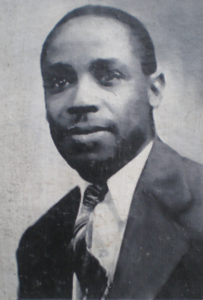By Jerry Klinger


ROCKVILLE, Maryland — One can live in a neighborhood and never know the Jewish story that was right in front of them. I lived in Rockville for more than forty years. I never knew the long road ending public school segregation in America began in a Jewish funded public elementary school, the (Rosenwald) Rockville Colored Elementary School on N. Washington Street.
The small four-room building is gone today. A modern five-story apartment condo sits on the forgotten historic school site that led to the landmark, 1954 U.S. Supreme Court decision, Brown v. Board of Education. The Brown decision upended, long settled law, long-established precedent, upended Stare Decisis, it ended the 1896 U.S Supreme Court decision of Plessy v. Ferguson which had affirmed the constitutionality of segregation in public facilities, such as schools, buses, etc., with a caveat. The separate had to be equal. Separate but equal was always separate but never equal.
A young Black educator at Rockville Elementary decided to take a stand. He wrote a letter in 1936 to Thurgood Marshall of the NAACP in New York asking for help. It said:
“It is my desire to enlist you against the State of Maryland for equalization of salaries for Negro Teachers. However, I am entirely devoid of funds with which to carry out my wishes. Would it be possible for me to secure financial aid from the NAACP to proceed with this legal suit?I am a graduate of the West Chester State Teacher’s College of West Chester Pa. I have a two- year normal school diploma and some credits toward my B.S. in education. I have been teaching in Maryland for five y ears. At the present I am principal of a four-room school here in Rockville, Montgomery Co. The term of court in this county convenes on Nov. 9, 1936 and will last about three months. If possible, I should like to have the case filed so that it may be heard during this falls court term. Therefore, an early reply from you, regarding the financial assistance, in this matter will be greatly appreciated. Yours truly, Wm. B. Gibbs Jr.”
Gibbs had approached the NAACP earlier. The local Baltimore chapter interviewed him before he was referred to New York. It was important to the NAACP that first, a formal letter requesting assistance come to them. They were afraid to be seen as “outside agitators” seeking plaintiffs, to cause trouble in Maryland, a Southern border state.
William B. Gibbs Jr. was born July 26, 1905, in West Chester, Pennsylvania. He grew up in West Chester, graduating from West Chester High School. Gibbs continued his education at the all Black West Chester College. He earned a two-year degree in elementary education. In 1930 Gibbs secured a position as the acting principal and teacher of the (Rosenwald) Rockville, Montgomery County, Maryland, Colored Elementary School.
The Rosenwald school in Rockville was one of over 5,000 schools funded by Jewish American philanthropist Julius Rosenwald. Rosenwald’s educational efforts, and his enormous personal fortune, provided educational opportunities to nearly 40% of Black Americans in the 15 States of the South.
Rosenwald felt in a country that Blacks and Whites shared together, Democracy could not survive if large swaths of the American electorate were “half educated and half ignorant.” Rosenwald’s help was unprecedented.
Courageously, William Gibbs Jr. volunteered to be the NAACP’s plaintiff against the Montgomery County, Maryland School Board of Education. The complaint was about pay equity discrimination. The case became known as Gibbs v. Broome.
Broome was the head of the Montgomery County School Board. Thurgood Marshall later become the first Black American Supreme Court Justice. Marshall was a brilliant young attorney, just out of law school. The Gibbs case was Marshall’s second since graduating. Marshall became the lead counsel.
Montgomery County school policy in 1936, when Gibbs filed his complaint, required Black educators, doing the same work as White educators, to earn approximately 1/2 as much as White educators.
Marshall sued the school board using a legal strategy structured around the denial of Gibbs’ 14th Amendment rights and the 1896 U.S. Supreme Court decision in Plessy v. Ferguson.
Broome’s attorneys attempted to throw the Gibbs suit out. They lost before a three-judge panel in the Rockville Court. Gibbs was separate and certainly not being paid equally with Whites.
Recognizing their legal position was untenable, the Montgomery County Board of Education settled out of court in 1937. Over the next two years, Black Montgomery County educators saw their pay rise to parity with White teachers.
The Maryland court victory by the NAACP propelled hundreds of local chapters of the NAACP being formed throughout of the South.
The legal arguments developed by Marshall in the Gibbs case laid the foundation for similar arguments he and others would make in the landmark 1954 United States Supreme Court decision, Brown vs. Board of Education. Marshall’s co-counsel before the Supreme Court was Jack Greenberg. Greenberg was the only White lawyer, and a Jew, at the time working with the NAACP. When Thurgood Marshall became an Associate Justice of the U.S. Supreme Court in 1967, Greenberg assumed Marshall’s role at the NAACP. Greenberg became the Director Counsel of the NAACP Legal Defense Fund until his retirement in 1984.
Using a technicality, the Montgomery County School Board fired Gibbs a year after the out of court settlement.
Gibbs returned to elementary education in 1940. He became the principal of Auburn Elementary School in Swedesboro, New Jersey. He later served as a Junior High School teacher until his retirement in 1971.
A man of deep religious convictions and positive outlook, in 1944 William Gibbs became a pastor with the African Methodist Episcopal (AME) Zion Church. He maintained that role until his death. Gibbs died in Bryn Mawr, Pennsylvania on December 27, 1984. He was 79 years of age. Friends and family buried him in West Chester, Pennsylvania.
Gibbs v. Broome became one of the cases leading to Brown V. Board of Education which ended legal school segregation in the United States. Gibbs v. Broome also became the foundation for the pay equity struggle for women and other pay-discriminated groups in the U.S. Gibbs v. Broome became part of the argument for today’s, still unratified, Equal Rights Amendment.
The Jewish American Society for Historic Preservation (JASHP) has offered a Rockville Historical organization to fund a historic interpretive marker at the site of the (Rosenwald) Rockville Colored Elementary School. Progress is slow. JASHP is currently working with the Montgomery County Parks to place a historic interpretive marker at one of the few still standing Rosenwald Schools in the County, the Rosenwald Norbeck School.
*
Jerry Klinger is President of the Jewish American Society for Historic Preservation
The Rosenwald story is another story that is not well known. He was a very important part in the Sears /Roebuck story as well as funding his “colored” schools in the South.
God bless you Jerry Klinger. I can only imagine that as a Jewish American, a member of a group that often experiences prejudice, you have the sensitivity to feel the prejudices inflicted on Black Americans, and accordingly you bring it to public attention.